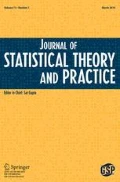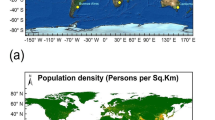Abstract
Fine particulate matter (PM2.5) is an atmospheric pollutant that has been linked to serious health problems, including mortality. PM2.5 has five main components: sulfate, nitrate, total carbonaceous mass, ammonium, and crustal material. These components have complex spatial-temporal dependency and cross dependency structures. It is important to gain better understanding about the spatial-temporal distribution of each component of the total PM2.5 mass, and also to estimate how the composition of PM2.5 changes with space and time to conduct spatial-temporal epidemiological studies of the association of these pollutants and adverse health effects. We introduce a multivariate spatial-temporal model for speciated PM2.5. Our hierarchical framework combines different sources of data and accounts for bias and measurement error in each data source. In addition, a spatiotemporal extension of the linear model of coregionalization is developed to account for spatial and temporal dependency structures for each component as well as the associations among the components. We apply our framework to speciated PM2.5 data in the United States for the year 2004.
Similar content being viewed by others
References
Baumgardner, R.E., Isil, S.S., Bowser, J.J., Fitzgerald, K.M., 1999. Measurements of rural sulfur dioxide and particle sulfate: Analysis of CASTNet data, 1987 through 1996, Journal of Air Waste Management Association, 49, 1266–1279.
Flanagan, J.B., Peterson, M.R., Jayanty, R.K.M., Rickman, E.E., 2003. Analysis of Speciation Network Carbon Blank Data, RTP, NC: RTI International.
Frank, N.H., 2006. Retained nitrate, hydrated sulfates, and carbonaceous mass in federal reference method fine particulate matter for six eastern U.S. cities, Journal of Air Waste Management Association, 56, 500–511.
Fuentes, M., Song, H., Ghosh, S.K., Holland, D.M., Davis, J.M., 2006. Spatial association between speciated fine particles and mortality, Biometrics, 62, 855–863.
Gelfand, A.E., Smith, A.F.M., 1990. Sampling-based approaches to calculating marginal densities, Journal of the American Statistical Association, 85, 398–409.
Gelfand, A.E., Banerjee, S., Gamerman, D., 2005. Spatial process modelling for univariate and multivariate dynamic spatial data, Environmetrics, 16, 465–479.
Grzebyk, M., Wackernagel, H., 1994. Multivariate analysis and spatial/temporal scales: real and complex models, in Proceedings of the XVIIth International Biometrics Conference, pp. 19–33.
Malm, W.C., Schichtel, B.A., Ames, R.B., Gebhart, K.A., 2002. A 10-year spatial and temporal trend of sulfate across the United States, Journal of Geophysical Research, 107, D224627, doi:10.1029/2002JD002107.
Malm, W.C., Schichtel, B.A., Pitchford, M.L., Ashbaugh, L.L., Eldred, R.A., 2004. Spatial and monthly trends in speciated fine particle concentration in the United States, Journal of Geophysical Research, 109, D03306, doi:10.1029/2003JD003739.
McFadden, D., 1974. Conditional logit analysis of qualitative choice behavior, in Frontiers of Econometrics, P. Zarembka (editor), New York: Academic Press, pp.105–142.
Özkaynak, H., Thurston, G.D., 1987. Associations between 1980 U.S. mortality rates and alternative measures of airborne particle concentration, Risk Analysis, 7, 449–461.
Rao, V., Frank, N., Rush, A., Dimmick, F., 2003. Chemical speciation of PM2.5 in urban and rural areas, National Air Quality and Emissions Trends Report, pp. 13–23.
Spiegelhalter, D.J., Best, N.G., Carlin, B.P., van der Linde, A., 2002. Bayesian measures of model complexity and fit (with discussion), Journal of the Royal Statistical Society B, 64, 583–639.
U.S. Environmental Protection Agency, 1997. National Ambient Air Quality Standards for Particulate Matter; Final Rule, Part II, Federal Register, 40, CFR Part 50.
U.S. Environmental Protection Agency, 2000. Quality assurance guidance document, quality assurance project plan: PM2.5speciation trends network field sampling, EPA 454/R-01-001, RTP, NC, Available at: http://www.epa.gov/ttn/amtic/files/ambient/pm25/spec/1025sqap.pdf.
U.S. Environmental Protection Agency, 2003. National air quality and emissions trends report, 2003, special studies edition, EPA 454/R-03-005, RTP, NC, Available at: http://www.epa.gov/air/airtrends/aqtrnd03/.
Wackernagel, H., 1998. Multivariate Geostatistics — An Introduction with Applications, 2nd edition, New York: Springer-Verlag.
Wikle, C.K., Milliff, R.F., Nychka, D., Berliner, M., 2001. Spatiotemporal hierarchical Bayesian modeling: Tropical ocean surface winds, Journal of the American Statistical Association, 95, 1076–1987.
Author information
Authors and Affiliations
Corresponding author
Rights and permissions
About this article
Cite this article
Choi, J., Reich, B.J., Fuentes, M. et al. Multivariate Spatial-temporal Modeling and Prediction of Speciated Fine Particles. J Stat Theory Pract 3, 407–418 (2009). https://doi.org/10.1080/15598608.2009.10411933
Received:
Revised:
Published:
Issue Date:
DOI: https://doi.org/10.1080/15598608.2009.10411933




